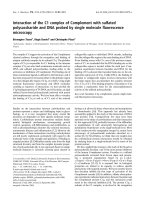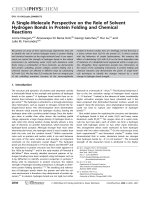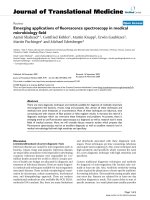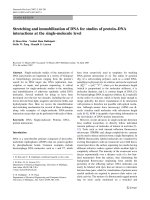Handbook of single molecule fluorescence spectroscopy
Bạn đang xem bản rút gọn của tài liệu. Xem và tải ngay bản đầy đủ của tài liệu tại đây (4.48 MB, 279 trang )
www.pdfgrip.com
Handbook of Single Molecule
Fluorescence Spectroscopy
www.pdfgrip.com
This page intentionally left blank
www.pdfgrip.com
Handbook of
Single Molecule
Fluorescence
Spectroscopy
Chris Gell
Laser facilities Manager, Institute of Molecular Biophysics,
University of Leeds
David Brockwell
Lecturer, School of Biochemistry and Microbiology,
University of Leeds
Alastair Smith
Director, Institute of Molecular Biophysics,
University of Leeds
1
www.pdfgrip.com
3
Great Clarendon Street, Oxford OX2 6DP
Oxford University Press is a department of the University of Oxford.
It furthers the University’s objective of excellence in research, scholarship,
and education by publishing worldwide in
Oxford New York
Auckland Cape Town Dar es Salaam Hong Kong Karachi
Kuala Lumpur Madrid Melbourne Mexico City Nairobi
New Delhi Shanghai Taipei Toronto
With offices in
Argentina Austria Brazil Chile Czech Republic France Greece
Guatemala Hungary Italy Japan Poland Portugal Singapore
South Korea Switzerland Thailand Turkey Ukraine Vietnam
Oxford is a registered trade mark of Oxford University Press
in the UK and in certain other countries
Published in the United States
by Oxford University Press Inc., New York
© Oxford University Press 2006
The moral rights of the authors have been asserted
Database right Oxford University Press (maker)
First published 2006
All rights reserved. No part of this publication may be reproduced,
stored in a retrieval system, or transmitted, in any form or by any means,
without the prior permission in writing of Oxford University Press,
or as expressly permitted by law, or under terms agreed with the appropriate
reprographics rights organization. Enquiries concerning reproduction
outside the scope of the above should be sent to the Rights Department,
Oxford University Press, at the address above
You must not circulate this book in any other binding or cover
and you must impose the same condition on any acquirer
British Library Cataloguing in Publication Data
Data available
Library of Congress Cataloging in Publication Data
Data available
Typeset by Newgen Imaging Systems (P) Ltd., Chennai, India
Printed in Great Britain
on acid-free paper by
Biddles Ltd. www.biddles.co.uk
ISBN 0–19–852942–2
10 9 8 7 6 5 4 3 2 1
978–0–19–852942–2
www.pdfgrip.com
“There is nothing, Sir, too little for so little a creature as man. It is by studying little
things that we attain the great art of having as little misery and as much happiness as
possible.”
Samuel Johnson, 1763
www.pdfgrip.com
This page intentionally left blank
www.pdfgrip.com
Preface
The development of techniques capable of studying the properties of an individual
molecule have been strongly driven by new applications in drug discovery and
quantum information processing for example, and by an interest in the heterogeneity in the physical, chemical, and biological properties within an ensemble of
molecules. Tools for studying the structure and photochemistry of single
molecules are now well established and becoming available to a broad range of
non-specialist scientists. The most widely used spectroscopic probe at the single
molecule level is fluorescence, due to the relatively high quantum efficiency of the
process compared with other possible probes. In molecular biology in particular,
we have recently seen much wider use of single molecule techniques such as
fluorescence resonance energy transfer and fluorescence correlation spectroscopy
that have revealed new and interesting kinetic and structural information about a
variety of macromolecules.
This book is aimed at experimental scientists with a physical chemistry or
biochemistry background who wish to enter this new and exciting field of research
and to apply single molecule fluorescence techniques to studies of macromolecular
structure and function. The book is designed to present a complete introduction,
from the motivation for single molecule experiments to their implementation and
the analysis of results.
In Chapter 1 the motivation for single molecule experiments is discussed.
Experiments capable of resolving individual molecules are described as a probe of
heterogeneity and identification of rare states that are lost within the average
signal obtained from conventional ensemble measurements. Then the core experiments and techniques are outlined along with an overview of the information
content of the resulting data. In Chapter 2, detailed phenomenological and
mathematical descriptions of three principle single molecule fluorescence
methods are given (fluorescence correlation spectroscopy, fluorescence resonance
energy transfer, and the photon counting histogram). These powerful techniques
are discussed in detail along with the methodologies and special considerations
needed to collect and analyse the data. In Chapter 3, a thorough description of the
implementation of these techniques is presented including many aspects of
optical design. In particular, apparatus for far field confocal and total internal
reflection type geometries is described in detail. The aim of this chapter is to give
the reader a complete practical insight into the realization of single molecule
fluorescence experiments. With the framework of motivation, technique, and
instrumentation firmly established, Chapter 4 discusses a number of practical
www.pdfgrip.com
viii PREFACE
considerations. These include selection of chromophores, both intrinsic to the
molecule and extrinsic dye molecules, suitable as fluorescent reporters of structure
or function. The practicalities of labelling large macromolecules, that is, the chemical attachment of extrinsic dyes to (principally) biological molecules, will also be
described in detail since it presents a significant barrier to be overcome in single
molecule spectroscopy. The immobilization of molecules on surfaces and within
matrices, as well as purification and other related issues for sample preparation
will also be discussed. Chapters 5 and 6 will provide a review of the applications of
single molecule fluorescence spectroscopy, and discuss these with relation to the
practical problems that have been encountered and overcome and the potential
for new experiments that are exposed. The corollary in Chapter 7 highlights the
exciting outlook for the analysis of individual molecules, with particular attention paid to fundamental studies of biomolecular structure and conformational
dynamics.
The authors intend that this volume will give the reader a complete guide to the
practical implementation of single molecule experiments and stimulate the same
excitement they feel for this growing field.
Chris Gell
David Brockwell
Alastair Smith
www.pdfgrip.com
Contents
ACKNOWLEDGEMENTS
GLOSSARY OF TERMS AND SYMBOLS
1 Introduction
xi
xiii
1
1.1
Motivation
1.2
A historical perspective
2
1.3
This book
3
1.4
1
Single molecule measurements
5
References
8
2 Single molecule fluorescence techniques
10
2.1
Introduction
10
2.2
Burst analysis
10
2.3
Photon counting histograms
12
2.4
Fluorescence correlation spectroscopy
24
2.5
Fluorescence resonance energy transfer
44
2.6
Measurements of immobilized single molecules
66
2.7
Other related techniques
80
References
89
3 Single molecule fluorescence instrumentation
97
3.1
Introduction
3.2
Optical arrangements for single molecule detection
3.3
Methods for discriminating signal from noise
119
3.4
Wavelength or polarization selection optics
122
3.5
Excitation sources
124
3.6
Microscope objectives for single molecule fluorescence detection
127
3.7
Detectors for single molecule fluorescence experiments
133
3.8
Acquisition cards and software
140
3.9
97
102
Realizing single molecule instrumentation
142
References
155
www.pdfgrip.com
x CONTENTS
4 Preparation of samples for single molecule fluorescence
spectroscopy
159
4.1
Introduction
159
4.2
Dye selection
160
4.3
Labelling of biomolecules
172
4.4
Doubly labelling single protein molecules for FRET studies
180
4.5
Optimizing biochemical systems for single molecule
fluorescence studies
186
4.6
Immobilization methods
189
References
196
5 Fluorescence spectroscopy of freely diffusing
single molecules: examples
201
5.1
Introduction
201
5.2
Single molecule studies of freely diffusing molecules
201
References
224
6 Fluorescence spectroscopy of immobilized
single molecules: examples
6.1
6.2
Introduction
INDEX
225
Single molecule studies of immobilized molecules
226
References
247
7 The outlook for single molecule fluorescence
measurements
7.1
225
249
Outlook
249
References
252
255
www.pdfgrip.com
Acknowledgements
The authors thank everyone who has had some input into the compilation and
editing of this text. In particular we acknowledge collaborators Sheena Radford,
Peter Stockley, and Nicola Stonehouse, all at Leeds University, without whom
much of the work that provided the motivation for this text would not have been
performed. The ongoing projects conceived with them, and the questions they
asked, led to our need to implement many of the techniques we describe. The
lessons we learnt (and are still learning) provided the basis to enable us to write
this text—hopefully it will help anyone else with similar questions.
Much of the data that we present was measured (unless otherwise referenced)
by scientists working in the Institute of Molecular Biophysics in Leeds. In particular we thank Tomoko Tezuka-Kawakami, Tara Sabir, Rob Leach, Sara Pugh,
Jennifer Clark, and Mark Robinson. We are also very grateful to Clive Bagshaw
for critical reading of the manuscript. For informal, but precise, editorial input
we are indebted to Claire Friel and Kurt Baldwin. We also thank Andrea Rawse
for her efforts in obtaining reprint permissions.
Chris Gell
David Brockwell
Alastair Smith
www.pdfgrip.com
This page intentionally left blank
www.pdfgrip.com
Glossary of terms and symbols
Here we list a number of mathematical symbols, specialist terms, and acronyms
used throughout this text. Where possible we have used the commonly accepted
convention, although some duplication and repetition is present as symbols and
acronyms are not always used consistently in the literature. In places we have
indeed used different symbols to identify the same parameters. Generally, this is
in order to maintain consistency with the nomenclature found in the original
work that we describe or review.
Å
AFM
ALEX
APD
Apo
BFP
Angstroms
atomic force microscopy
alternating laser excitation
avalanche photodiode
apochromatic
back focal plane (the focal plane typically on the illumination side of
the lens)
bp
base pair/s
BSA
bovine serum albumin
CCD
charge coupled device
CEF
collection efficiency function (see PSF)
CMOS
complimentary metal oxide semiconductor
Corr{x,y} mathematical correlation of x and y
cpspm
counts per second per molecule
D
penetration depth, beam diameter, aperture diameter, translational
diffusion coefficient
DC
value to which the autocorrelation function decays—the baseline
(typically 1)
DLL
dynamic linked library
DTT
dithiothreitol
e
base of the natural logarithm function
(e ϭ exp(1) ϭ 2.71828)
EFRET
fluorescence resonance energy transfer efficiency
viscosity
I
proportionality constant between the amount of light falling on a
detector and detected signal
x
detection efficiency of x
www.pdfgrip.com
xiv GLOSSARY OF TERMS AND SYMBOLS
⑀
EMCCD
ESI-MS
f
FT
FAM
FAMS
FCS
FIDA
FITC
Fluor
FRET
␥
molecular brightness (see cpspm)
electron multiplying charge coupled device
electro-spray ionization mass spectrometry
focal length
FCS triplet fraction (molecule in the triplet state)
carboxyfluorescein
fluorescence aided molecular sorting
fluorescence correlation spectroscopy
fluorescence intensity distribution analysis
reactive isothiocyanate form of fluorescein
fluorite
fluorescence resonance energy transfer
constant depending on the PSF (in FCS), constant accounting for differential detection efficiencies, and quantum yields of the donor and
acceptor in spFRET detection
g3DG()
diffusion only part of the analytical description of the autocorrelation
function with the sample volume (PSF) approximated to a threedimensional Gaussian
G()
autocorrelation function with lag-time (see )
GdnCl
guanidine chloride
GdnHCl guanidine hydrochloride
GFP
green fluorescent protein
HPLC
high-performance liquid chromatography
Hz
hertz
IA
number of acceptor photon counts
ID
number of donor photon counts, light intensity at the detector
I(f)
Fourier transform of the intensity signal I(t)
I*(f)
complex conjugate of the Fourier transform of the intensity signal I(t)
IA
iodoacetamide
IC
internal conversion (photophysics)
ICCD
intensified charge coupled device
ISC
inter-system crossing (photophysics)
ISF
instrument spread function
J
spectral overlap integral (spFRET)
electric dipole orientation factor (spFRET)
k
photon counts per unit time interval, Boltzmann constant
kB
Boltzmann constant
2
k
PSF shape parameter in FCS ( ϭ 0/z0)
Kd
disassociation constant
kx
rate constant for the process x
www.pdfgrip.com
GLOSSARY OF TERMS AND SYMBOLS xv
wavelength
micro-, mean or moment
m
mth moment of
n
refractive index
M
molarity
2
M
laser beam quality parameter
MAFID moment analysis of the fluorescence intensity distribution
MCP
micro channel plate
MCS
multi channel scalar card
NA
Avogadro’s number
N
time averaged number of molecules in the PSF
NA
numerical aperture
Nd:YAG neodymium-doped yttrium aluminum garnet, (a typical solid laser
gain medium)
NsmϪ2
Newton seconds per square meter
0
radius of the point spread function perpendicular to the optic axis
OD
optical density
OPSL
optically pumped semiconductor laser
p(k)
probability distribution or PCH of k
(1)
p (k,x) PCH for a 1 particle system with photon counts k and involving parameters x
(fixed)
p
(k,x) PCH for a particle fixed at the origin with photon counts k and involving parameters x
P
proximity ratio (in spFRET)
PFRET
proximity ratio (in spFRET)
PCH
photon counting histogram
PCI
peripheral component interconnect
PCR
polymerase chain reaction
PEG
polyethylene glycol
Poi(k,x) a Poisson distribution of the independent variable k, involving parameters x
PMMA polymethyl-methacrylate
PMT
photomultiplier tube
PSF
point spread function
PVA
polyvinyl alcohol
r
anisotropy
r0
intrinsic molecular anisotropy
RNA
ribonucleic acid
standard deviation
S
stoichiometry based ratio in ALEX
www.pdfgrip.com
xvi GLOSSARY OF TERMS AND SYMBOLS
Sx
SCM
SDF
SH
smMFD
spFRET
D
R
T
TCSPC
TMR
T
Q
QD
QE
R
R0
⌽x
T
TA/D
TCEP
TEM
TIR
TIRF
TIRFM
TTL
UV
Vx
V0
z0
ϽkϾ
Ͻ⌬k2Ͼ
ᮏ
singlet level x (photophysics)
scanning confocal microscopy
spatial detectivity function (see PSF)
sulphydryl group
single molecule multiparameter fluorescence detection
single pair fluorescence resonance energy transfer
lifetime, lag-time (correlation time or delay time)
FCS diffusion time
reaction rate for a reversible two-state process manifesting in the FCS
autocorrelation function
FCS triplet correlation time
time correlated single photon counting
tetramethylrhodamine
rotational correlation time (in anisotropy)
angle (degrees)
critical angle for total internal reflection
quantum yield
quantum yield of the donor dye (spFRET)
quantum efficiency
scalar dye separation in spFRET
Förster distance (spFRET, R for 50% transfer efficiency)
quantum yield of x
threshold (in spFRET), temperature
threshold for the donor or acceptor detection channel (in spFRET)
tris(2-carboxyethyl)phosphine hydrochloride
transverse electromagnetic mode
total internal reflection
total internal reflection fluorescence
total internal reflection fluorescence microscope/microscopy
transistor transistor logic
ultra-violet part of the electromagnetic spectrum
vibrational energy level
volume (typically of the PSF)
radius of the point spread function in the direction of the optic axis
mean of k
variance of k
mathematical convolution operation
www.pdfgrip.com
ONE
Introduction
1.1 Motivation
The measurement of single fluorescent molecules is,in principle,straightforward as
suitable detectors, light sources, and sampling optics are readily available. The
major hurdle lies in the interference from the massive excess of other molecules that
contribute to the background, along with photophysical artifacts from the dye
labels, that both reduce the signal-to-noise of the measurement. So what is the
motivation for facing the challenges of making measurements with single molecule
resolution? The simplest reason is the need to achieve very high sensitivity. Single
molecule measurements represent the ultimate level of sensitivity—the ability to
detect 1.66 ϫ 10Ϫ24 mole of the object of interest (1.66 yoctomole), that is, the
inverse of Avogadro’s number, which has also been referred to as a ‘guacamole’.
Sensitivity is clearly a strong driving force in applications such as pathology and
diagnostic medicine in which one would ideally like to be able to detect one copy of
a protein or gene, perhaps within a cell, that is indicative of disease. Measurement
sensitivity will also be key to overcoming the contemporary challenges of studying
and developing nanoscale devices and subsequently interfacing with them.
Nanotechnology is creating new requirements for optical and photonic probes for
which single molecule techniques can provide solutions. As well as high sensitivity,
single molecule measurements also provide information about the environment
local to the probe fluorophore with extremely high spatial resolution. A conventional microspectroscopy measurement typically samples a volume of 105 nm3 and
even near-field optical probes, which avoid the diffraction limit to spatial resolution
(which is of the order of half the wavelength of light used in conventional optical
microscopies), sample several hundreds of cubic nanometres. However, an individual
molecule samples its surroundings within a much smaller volume, possibly only a
few cubic nanometres and can therefore relay chemical information with very high
spatial resolution and probes the local environment with similar resolution, providing a valuable interface with the macroscopic world.
Importantly, single molecule spectroscopy has other merits in addition to
sensitivity and high resolution.Measurements of concentrated samples yield only an
ensemble average of the properties of interest and provide no means of assessing the
heterogeneity of complex systems. Single molecule spectroscopy on the other hand
www.pdfgrip.com
2 INTRODUCTION
provides an insight into the behaviour of each individual molecule and therefore
allows the detail of subpopulations in structure or dynamics within an ensemble to
be delineated. In addition, single molecule methods provide a way of probing fluctuating systems under equilibrium conditions, allowing kinetic pathways to be studied
without the need for synchronization.For example, in a typical ensemble experiment
designed to observe protein folding kinetics, the folding of many molecules must be
synchronized by some starting event such as a rapid temperature increase [1], pH
jump [2] or change in the chemical conditions by mixing two solutions [3]. If the
kinetics of each molecule are not synchronized in an ensemble experiment then the
kinetic rate constants cannot be measured. Such initiating events have finite duration; for example, mixing two solutions requires hundreds of microseconds or milliseconds [3] depending on the experimental design. Therefore, the synchronization
event in ensemble experiments creates a dead time for observation that can make it
impossible to observe early kinetic events that may determine the route taken
through the folding energy landscape. Single molecule measurements intrinsically
require no such synchronization and therefore reaction or folding kinetics can, in
principle, be studied with shorter dead time. The ability of single molecule measurements to observe heterogeneity in kinetic pathways by a series of measurements
allows the experimentalist to dissect the ensemble average.This procedure may allow
rare intermediates to be observed that would be swamped by the signal from more
abundantly populated states in an ensemble experiment. This is perhaps the key
motivation for many researchers adopting single molecule techniques.
Finally, it should be noted that single molecule measurements can also provide
an important direct comparison with theory and the results of computer simulations. Many theoretical approaches and computer simulations inherently deal
with the properties of an individual molecule; a comparison with the average
properties of the system yielded by ensemble experiments may therefore be far
from ideal. Single molecule measurements require no assumption about how
molecular properties scale to the bulk and these studies thus allow direct comparison with the results of theory and simulations.
1.2 A historical perspective
Arguably the first single molecule spectroscopic measurement was made by
Rotman in the 1960s [4] in which a single enzyme was detected indirectly
through its reaction products. However, Hirschfeld [5, 6] was probably the first to
make direct measurements with single molecule sensitivity when he demonstrated the detection of an individual antibody molecule, albeit labelled
with ~100 fluorophores! One can argue that his is not the seminal work but
www.pdfgrip.com
INTRODUCTION 3
Hirschfeld’s contributions were significant since he recognized the need for
reduced excitation and collection volumes and discussed photobleaching as one
of the essential limitations in single molecule spectroscopy. Moerner and Kador
[7,8] clearly demonstrated the detection of an individual molecule using absorption measurements at low temperature in 1989 and since then there has been a
rapid growth in the number of reports of single molecule spectroscopy focusing
mainly on fluorescence studies, the first of which was made by Orrit [9]. Keller’s
group at Los Alamos [10–12] was one of the major contributors to the development of room temperature single molecule spectroscopy in fluids. Their work
had a great influence on the growth in interest of single molecule fluorescence
measurements of biological molecules under physiological conditions. Betzig
[13] made significant contributions to the field in the early nineties by using nearfield fiber optical probes to detect single fluorophores immobilized on surfaces
and showed that the orientation of their transition dipole moments could be
mapped using the technique. However, the field really began to gain momentum
when a simple confocal optical microscope arrangement was shown to be capable
of making single molecule measurements [14–16]. The simplicity and relatively
low cost of this approach has, over the last 10 years, resulted in an explosion in the
number of publications applying single molecule techniques in chemistry,
physics, and biophysics. A recent step was made when wide field microscopy was
used to image single molecules immobilized on surfaces using a total internal
reflection illumination geometry and an intensified Charge Coupled Device camera, and this arrangement has since proved the method of choice for studying
immobilized biological systems and even individual molecules within cells
[17,18]. Along with the development of optical arrangements came the methods
for analyzing the data. In the case of freely diffusing molecules, the fluorescence
bursts can be analysed in terms of their brightness, duration, polarization, and
fluorescence lifetime or wavelength using correlation spectroscopy or other statistical methods, which will be discussed in some detail in Chapter 2. In the case of
immobilized molecules similar statistical approaches can be employed to the time
series of fluorescence photons emitted by a single molecule to report on dynamical processes such as protein folding or the action of molecular motors.
1.3 This book
Although absorption and Raman spectroscopy [19,20] have also been shown to provide single molecule sensitivity, we shall concentrate in this book on fluorescence
techniques and their applications. This is by no means a limitation; fluorescence spectroscopy and microscopy provides a vast range of opportunities for
www.pdfgrip.com
4 INTRODUCTION
experiments in physics, chemistry and biology owing to the availability of new
detectors and light sources, fluorescent dyes and labelling chemistries coupled to
the never ending supply of fascinating problems. In the remaining sections of this
chapter we provide a simple phenomenological introduction of the two core
groups of single molecule fluorescence experiments: measurements of diffusing
single molecules and measurements of immobilized single fluorescent molecules,
in order to provide the reader with a basic understanding of the experiments and
the information content of the data. Subsequent chapters then greatly expand
upon this brief overview: in Chapter 2, detailed phenomenological and mathematical descriptions of three major single molecule fluorescence methods are
given (fluorescence correlation spectroscopy, fluorescence resonance energy
transfer and the photon counting histogram) along with a discussion of the
simpler analysis of data resulting from studies on immobilized molecules. In
Chapter 3, a thorough description of the implementation of these techniques is
presented including simplified aspects of optical design and data collection. In
particular, basic apparatus for far-field confocal, far-field multi-photon and total
internal reflection geometries are described in detail. The aim of this chapter is to
give the reader a practical insight into the implementation of single molecule
fluorescence measurements. With the framework of technique and instrumentation firmly established, Chapter 4 discusses a number of practical considerations.
These include selection of chromophores, both intrinsic molecular fluorophores
and extrinsic dye molecules that are suitable as fluorescent reporters of structure
or function, along with a basic introduction to dye photophysics relevant to single
molecule work. The practicalities of labelling large macromolecules, that is, the
chemical attachment of extrinsic dyes to (principally) biological molecules, will
also be described since it represents a significant challenge that has to be overcome
prior to making single molecule measurements. The immobilization of molecules on surfaces and within matrices as well as purification and other related
issues for sample preparation will also be discussed. Chapters 5 and 6 will provide
a non-exhaustive review of existing applications of single molecule fluorescence
spectroscopy, and discuss these in relation to the practical problems that have
been encountered and overcome. The potential for new experiments that are
exposed as a result of these studies are also highlighted. The corollary in Chapter 7
highlights the exciting outlook for single molecule fluorescence analysis.
This book is aimed at experimental scientists with a physical chemistry or
biochemistry background who wish to enter this new and exciting field of research
and to apply single molecule fluorescence techniques to studies of macromolecular
structure and function. The book is designed to present an introduction to the topic,
from the practical implementation of single molecule fluorescence experiments,
through methods of data analysis to a description of a range of current and future
www.pdfgrip.com
INTRODUCTION 5
applications. We hope that we have provided enough useful information to make
starting such experiments straightforward and rewarding.
1.4 Single molecule measurements
In this section we outline the two main types of single molecule measurement
that we have chosen to discuss in detail in this text; measurements on diffusing
fluorescent single molecules and measurements on immobilized single fluorescent molecules. We introduce the basic concepts of these experiments, which we
then expand upon in both a phenomenological and rigorous mathematical way
in subsequent chapters.
1.4.1 Diffusion studies
The basic concept of a single molecule diffusion fluorescence experiment is
illustrated in Figure 1.1. The labelled analyte (Figure 1.1(a)), in this case a
nucleotide stem – loop structure with a single fluorescent dye label at one terminus
and a quencher for this dye at the other terminus, is allowed to diffuse freely in
solution. The molecule can undergo a reversible conformational transition
between the folded (stem – loop) and unfolded (denatured random coil) conformations with some rate constants. The fluorescence from a small sample volume
(Ͻ0.1 femtolitre, Figure 1.1 (b)) in this solution is then monitored as a function
of time. When the analyte diffuses into the volume a transient burst of fluorescence is observed above the background level (Figure 1.1 (c)). The temporal
persistence of this burst is a function of a number of variables including: solvent
viscosity, molecule size, path through the volume, quantum yield of the dye and
the size of the volume. If the molecule is in a dynamic equilibrium, where the
energy barrier between the conformations is of the order of the energy available
to the system (~kBT, the Boltzman constant multiplied with the temperature),
then the molecule may, at any point, undergo a reversible transition to the other
conformation. If the rate of the conformational fluctuations (the observed rate
constant) is faster than the time taken to diffuse through the volume, then the
quenching or recovery of fluorescence for the folded and unfolded states, respectively, will modulate the burst between high and low signal levels (Figure 1.1(d)).
The amount of information contained within these bursts is large. Techniques
such as fluorescence correlation spectroscopy (FCS, Chapter 2) are able to extract
the average width (the amount of time) that fluctuations in the signal last for and
so can measure the width of the transients (i.e. diffusion coefficients) or the width
www.pdfgrip.com
6 INTRODUCTION
of the features within the modulated transients (i.e. the observed rate constant for
the dynamics). Further, by measuring for several minutes, sufficient statistics can
be built up to allow the analysis of the heights (intensities) of the transient bursts
through the fitting of histograms of the number of counts observed in each
counting interval (PCH, Chapter 2). These data can then be used to explore heterogeneity in the sample, if that heterogeneity is marked by species with differential mean intensities. If the analyte is labelled with two-dye molecules selected so
that inter-dye, distance-dependant energy transfer can occur, then measurements
of the signals from each dye simultaneously can revel both structural and
dynamic information by using single-pair fluorescence resonance energy transfer
analysis techniques (spFRET, Chapter 2).
(a)
(b)
–
(d)
60
40
20
0
0
5
10 15 20
Time (ms)
25
Photons (per 0.125 ms)
Photons (per 0.5 ms)
(c)
120
80
40
0
15
16
17 18 19
Time (ms)
20
Figure 1.1 Illustration of the concept of measuring the fluorescence from an individual single molecule diffusing in solution. (a) A molecule, which can undergo a reversible transition between a folded and unfolded
conformation, is labelled with a dye at one terminus and a quencher at the other. In the folded (native) conformation the fluorescence from the dye is quenched. In the unfolded (denatured) conformation the fluorescence is enhanced. (b) The molecule is allowed to diffuse freely in solution. Passage through the sample
volume is detected by fluorescence emission from the single dye label. (c) The resulting fluorescence signal in
a counting interval (0.5 ms), measured as a function of time, reveals transient bursts above a background.
Many bursts can occur, each from a different single molecule. (d) If the rate of reversible conformational fluctuations is faster than the diffusion time through the volume then the individual transient bursts are themselves modulated by the conformational dynamics and contain important information (assuming that the time
resolution is increased in order to follow the fluctuations).
www.pdfgrip.com
INTRODUCTION 7
1.4.2 Immobilization studies
One disadvantage of the measurement of freely diffusing single molecules is the
transient nature of the detected fluorescence, which means that in order to build
up statistics the measurements of many different single molecules are required.
Whilst such an experiment allows tremendous insight, such as resolution of
folded and unfolded protein species in a solution, some sensitivity to determine
heterogeneity may be lost due to the averaging over molecules within each state.
Further, it may not be possible to differentiate static or dynamic heterogeneity—
does each member of an ensemble (each folded molecule for example) provide
the same, but different for different molecules, time-invariant signal; or does each
molecule contribute an unsynchronized time-dependant signal.
Studies of immobilized single molecules can help to answer some of these
questions. In these experiments the time available to monitor the molecule in the
small observation volume is extended by immobilizing the molecule of interest,
either tethered to a substrate (generally a glass slide, Figure 1.2(b)) or by immobilization in a gel or tethered liposome. In this way the observation time is only
limited by the stability of the instrument used, the signal to noise ratio of the
(a)
(b)
(c)
Photons (per 100 ms)
–
1000
800
600
400
200
0
0
2
4
6
Time (s)
8
10
Figure 1.2 Illustration of the concept of measuring the fluorescence from an immobilized single molecule.
(a) A molecule, which can undergo a reversible transition between folded and unfolded conformations, is
labelled with a dye at one terminus and a quencher at the other. In the folded (native) conformation the
fluorescence from the dye is quenched. In the unfolded (denatured) conformation the fluorescence is
enhanced. (b) The molecule is immobilized (tethered) onto a solid substrate and the fluorescence signal from
a small volume near the surface monitored as a function of time. (c) The same molecule can be monitored for
a considerable length of time and the stochastic transitions (the number of which depend on the height of the
energy barrier for the transition) can be observed. Eventually (at around 9.5 s in this simulated example),
photobleaching of the dye occurs to a non-fluorescent state, at which point no more information can be
extracted from this molecule.
www.pdfgrip.com
8 INTRODUCTION
experiment and irreversible photobleaching of the dye to some non-fluorescent
state. In this way it is possible to monitor the fluorescence of a single molecule as
a function of time (an intensity trajectory) for up to several minutes
(Figure 1.2(c)). If sufficient time resolution and signal to noise is available in the
experiment then one can directly extract kinetic information for individual
molecules.As for diffusion techniques these studies can be extended with spFRET
to provide a powerful probe of structure and dynamics for complex systems.
Again, it may be necessary to combine the results of many individual molecules’
trajectories, but unlike the diffusion case little information is lost in this way.
1.4.3 Interpretation of single molecule data
In the examples described earlier much of the detail has been omitted. For
example, detailed statistical analysis of data is often necessary to determine the
reliability of any findings, as the data are often dominated by random contributions (for example, the path taken to diffuse through the volume and shot noise
from the detection of small numbers of photons per molecule). Of particular
concern is the photo-physics of the labels used: transient dark states, photobleaching, and quenching—all can be mistakenly interpreted as reporting on the
behaviour of the host molecule if care is not taken. Further, dye labelling and
immobilization must be shown not to perturb the molecule being probed in any
significant manner. In the remainder of this text we hope to give the reader an
introduction to many of these topics and hope that it enables the application of
these techniques in exciting new ways.
References
[1] Dimitriadis, G, Drysdale, A, Myers, JK, Arora, P, Radford, SE, Oas, TG, et al., Microsecond
folding dynamics of the F13W G29A mutant of the B domain of staphylococcal protein A by
laser-induced temperature jump. Proceedings of the National Academy of Sciences of the United
States of America 101 (2004) 3809–3814.
[2] Rami, BR and Udgaonkar, JB, pH-Jump-induced folding and unfolding studies of barstar:
Evidence for multiple folding and unfolding pathways. Biochemistry 40 (2001) 15267–15279.
[3] Roder, H, Maki, K, Cheng, H, and Shastry, MCR, Rapid mixing methods for exploring the
kinetics of protein folding. Methods 34 (2004) 15–27.
[4] Rotman, B, Measurement of Activity of single molecules of beta-D- galactosidase. Proceedings
of the National Academy of Sciences of the United States of America 47 (1961) 1981–1991.
[5] Hirschfeld, T, Optical microscopic observation of single small molecules. Applied Optics 15
(1976) 2965–2966.
[6] Hirschfeld, T, Quantum efficiency independence of time integrated emission from a fluorescent molecule. Applied Optics 15 (1976) 3135–3139.









